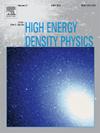Warm inflationary scenario in modified teleparallel gravity with matter-torsion coupling
IF 0.9
3区 物理与天体物理
Q3 PHYSICS, FLUIDS & PLASMAS
引用次数: 0
Abstract
This study investigates warm inflation in the context of modified teleparallel gravity specifically gravity under strong dissipative conditions (). We examine two inflationary potentials, Chaotic and Natural, evaluating scenarios with both constant and variable dissipation coefficients. For the Chaotic potential with a fixed dissipation parameter, the spectral index shows negligible sensitivity to the model’s parameters, while the tensor-to-scalar ratio depends markedly on them. Notably, certain choices for the potential exponent align well with Planck 2018 observational data. When the dissipation coefficient becomes variable, only one specialized case of the Chaotic potential remains consistent with observational limits. Here, shifts in model parameters dynamically adjust the relevant energy scales. Turning to the Natural potential, our analysis reveals that gravity corrections prove pivotal: they not only reshape the spectral index and tensor-to-scalar ratio but also allow the spontaneous symmetry breaking scale to dip below the Planck scale while still matching experimental constraints. These outcomes sharply contrast with cold inflation models, where analogous gravity modifications fail to salvage such potentials. Ultimately, we suggest that probing alternative functional forms and reevaluating other previously excluded potentials could deepen our understanding of warm inflation’s feasibility.
具有物质-扭转耦合的修正遥平行引力中的热暴胀情景
本研究探讨了在强耗散条件下修正遥平行重力,特别是f(T,T)重力背景下的热暴胀现象(r>1)。我们研究了两种暴胀潜力,混沌和自然,评估了恒定和可变耗散系数的情景。对于具有固定耗散参数的混沌势,谱指数对模型参数的敏感性可以忽略不计,而张量标量比则明显依赖于模型参数。值得注意的是,潜在指数的某些选择与普朗克2018年的观测数据非常吻合。当耗散系数变时,只有一种特殊情况的混沌势符合观测极限。在这里,模型参数的变化动态地调整了相关的能量尺度。转向自然势,我们的分析表明,f(T,T)引力修正证明是至关重要的:它们不仅重塑了谱指数和张量-标量比,而且还允许自发对称性破断尺度降至普朗克尺度以下,同时仍然符合实验约束。这些结果与冷暴胀模型形成鲜明对比,在冷暴胀模型中,类似的f(R,T)重力修正无法挽救这种潜力。最后,我们建议探索替代的f(T,T)函数形式并重新评估其他先前被排除的势可以加深我们对热暴胀可行性的理解。
本文章由计算机程序翻译,如有差异,请以英文原文为准。
求助全文
约1分钟内获得全文
求助全文
来源期刊

High Energy Density Physics
PHYSICS, FLUIDS & PLASMAS-
CiteScore
4.20
自引率
6.20%
发文量
13
审稿时长
6-12 weeks
期刊介绍:
High Energy Density Physics is an international journal covering original experimental and related theoretical work studying the physics of matter and radiation under extreme conditions. ''High energy density'' is understood to be an energy density exceeding about 1011 J/m3. The editors and the publisher are committed to provide this fast-growing community with a dedicated high quality channel to distribute their original findings.
Papers suitable for publication in this journal cover topics in both the warm and hot dense matter regimes, such as laboratory studies relevant to non-LTE kinetics at extreme conditions, planetary interiors, astrophysical phenomena, inertial fusion and includes studies of, for example, material properties and both stable and unstable hydrodynamics. Developments in associated theoretical areas, for example the modelling of strongly coupled, partially degenerate and relativistic plasmas, are also covered.
 求助内容:
求助内容: 应助结果提醒方式:
应助结果提醒方式:


